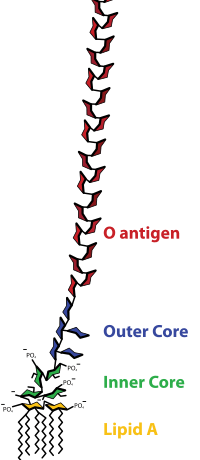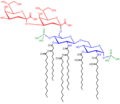Lipopolysaccharide facts for kids
Lipopolysaccharides (LPS), also called lipoglycans, are big molecules found in nature. They are made from two main parts: a lipid (which is like a fat) and a polysaccharide (which is like a sugar chain). These two parts are connected very strongly by a special link called a covalent bond.
LPS molecules are super important because they are found on the outside of certain types of bacteria. These bacteria are called Gram-negative bacteria. Think of LPS as the outer skin of these tiny germs.
Contents
What Are Lipopolysaccharides?
Lipopolysaccharides are complex molecules. They have a lipid part, which is fatty, and a sugar part, which is a long chain of sugar units. This unique structure helps them do their job in bacteria.
Where Do We Find LPS?
LPS are a key part of the outer layer of Gram-negative bacteria. These bacteria are very common. Some examples include E. coli, which can live in your gut, and Salmonella, which can cause food poisoning. The LPS on their surface helps protect them.
How LPS Affect Your Body
When Gram-negative bacteria enter an animal's body, the LPS on their surface acts like a signal. It tells the body's innate immune system that there's an invader.
LPS and Your Immune System
Your immune system has special detectors, like tiny sensors, called toll-like receptors. These sensors are found on certain immune cells, such as dendritic cells. When these sensors find LPS, they immediately know that bacteria are present. This causes a very strong immune response in the animal.
The immune response is your body's way of fighting off harmful germs. It can cause things like fever, inflammation, and other symptoms that help your body get rid of the bacteria. Because LPS can trigger such a strong reaction, they are sometimes called "endotoxins." This means they are toxins (harmful substances) that are part of the bacteria itself.
Images for kids
See also
 In Spanish: Lipopolisacárido para niños
In Spanish: Lipopolisacárido para niños



